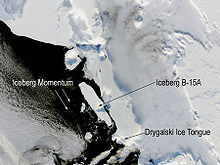B-15 A
Der Eisberg B-15 A in der Antarktis entstand aus dem über 11.000 Quadratkilometer großen Eisberg B-15, als dieser im Verlauf der Jahre 2000, 2002 und 2003 in mehrere Stücke zerbrach. Das größte verbleibende Stück hatte eine Größe von 6.400 Quadratkilometern und erhielt den Namen B-15 A[1]. Danach galt der C-19 A in der Nähe einer französischen Forschungsstation in der Antarktis als größter seiner Art.
Die Bezeichnung ergibt sich aus dem Ort, an dem der Eisberg zuerst gesichtet wurde: Das B steht für 90° bis 180° westliche Länge (Amundsen-See, östliches Rossmeer), das C für 90° bis 180° östliche Länge (westliches Rossmeer, Wilkesland).
B-15 A war 2005 etwa 3.000 Quadratkilometer groß und etwa 140 Kilometer lang und galt als das größte freischwimmende Objekt auf dem Weltmeer.
Bei einer Kollision mit der Drygalski-Eiszunge wurde diese fünf Kilometer kürzer, der abgebrochene Berg heißt nun C-16.
Weblinks
Einzelnachweise
- ↑ Kevin R. Arrigo, Gert L. Van Dijken: Annual changes in sea-ice, chlorophyll a, and primary production in the Ross Sea, Antarctica. In: Deep-Sea Research Part II: Topical Studies in Oceanography. 51. Jahrgang, Nr. 1–3. ScienceDirect, 2004, S. 117–138, doi:10.1016/j.dsr2.2003.04.003, bibcode:2004DSRII..51..117A (englisch, sciencedirect.com [abgerufen am 7. September 2018]).
Auf dieser Seite verwendete Medien
Found on Wikipedia.en GIS image showing the position of B-15A iceberg from 2003 to March 2006. Image made by Luca Pietranera. Information on the iceberg poositions derived by NASA-MODIS images (MODIS Rapid Response Rroject at NASA/GSI) and European Space Agency (ESA) ENVISAT,MERIS and ASAR sensors images.
The background is a part of the MODIS mosaic of Antarctica (Haran, T., J. Bohlander, T. Scambos, and M. Fahnestock compilers. 2005. MODIS mosaic of Antarctica (MOA) image map. Boulder, CO, USA: National Snow and Ice Data Center. Digital media).Italian station "Mario Zucchelli" and US McMurdo Station are highlighted on the map.The northern edge of the giant iceberg, B-15A, in the Ross Sea, Antarctica.
Iceberg B-15A is a fragment of a much larger iceberg (B-15) that broke away from the Ross Ice Shelf in March 2000. Scientists believe that the enormous piece of ice broke away as part of a long-term natural cycle (every 50-to-100 years, or so) in which the shelf--which is roughly the size of Texas--sheds pieces much as human fingernails grow and break off.
Researchers have placed global positioning systems (GPS), weather monitoring stations and four seismometers on different icebergs to track them. The goal is to learn more about what causes icebergs to calve, how and why they drift, what happens when the icebergs warm, and why they are producing previously unknown tremors that are picked up on seismometers as far away as Tahiti. Plans are to track B-15A until it disintegrates.
[Iceberg Update: In 2005 prevailing currents took B-15A slowly past the Drygalski ice tongue (an iceberg located in northern McMurdo Sound); the collision broke off the tip of Drygalski in mid-April. Iceberg B-15A sailed on along the coast leaving McMurdo Sound until it ran aground off Cape Adare in Victoria Land (a region of Antarctica lying south of New Zealand), where it broke into several smaller pieces on Oct. 27 and 28, 2005. The largest piece is still named B-15A (its surface is now approx. 1,700 square kilometres), while three additional pieces were named B-15P, B-15M and B-15N. It has since moved farther up north and broken up into more pieces. These were spotted by air force fisheries patrol on Nov. 3, 2006. On November 21, several large pieces were seen just 60 kilometres (37 mi) off the coast of Timaru, New Zealand, the largest measuring about 1.8 kilometres (1.1 mi) wide and 120 feet (37 m) high.]




